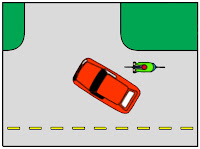Watch out for the Right Hook
 Fri, June 15, 2007
Fri, June 15, 2007  An accident so common it has a name: The Right Hook.
An accident so common it has a name: The Right Hook.
You are plugging along on your bicycle at about 15 or 20 mph on the right hand side of the road as you should be. A car approaches from behind; he is doing 30 or 40 mph and catches and passes you quite easily. But then the driver brakes and slows down to make a right turn.
Car brakes being as efficient as they are, he slows down quickly to about 15 or 20 mph, the same speed you are doing and as a result does not completely pass you. You are now along side the car, or a little behind the driver in his blind spot. He makes the right turn and you either run into the side of the car, he side swipes you, or in the worst case he runs right over you.
A good and careful driver would slow and stay behind the cyclist and wait until the bike rider clears the junction before he turns. Unfortunately, careful drivers are in the minority and it is really in a cyclist’s interest to ride defensively and be alert to hazards like this at all times.
First, be aware that you are approaching a turn off to the right; be it a road, entrance to a parking lot, or a driveway. Next, be aware of vehicles approaching from the rear. If they partially pass you then slow, it may be in your best interest to slow also. With your hands already on the brakes, you are ready for a panic stop.
If there is a separate right turn lane, do not ride your bike there unless you plan to turn right. Other road users will assume you are turning right, and you are asking to get hooked if you try to go straight.
I always look over my left shoulder as I approach a right turn lane and give a going left hand signal. Not an arm straight out left turn signal, but more just pointing at the road to my left to show, “I’m moving over to the next lane.”
Then I ride just outside the turn lane, close or on the lane marking. This gives vehicles plenty of room to pass on the right. You will still get the occasional joker who will pass you on the outside then cut in front of you to turn right. But I find a look over my left shoulder is the best signal to give, and most drivers will stay behind you when they see this.
Sometimes the lane markings are for straight ahead and right turn; in other words, it is not a lane designated for right turns only. In this case, I do the same glance over my left shoulder and if there is no one immediately behind me, I signal and move towards the center of the lane just so everyone knows I intend to go straight ahead. I try to do this at least 100 feet before the junction to cut down the risk of being right hooked. Once clear of the junction I move back over to the right.
Interval training is the best form of exercise, in terms of being good for the heart and for burning calories. I treat riding in traffic as interval training, slowing when caution is called for and reserving energy for when a sudden burst of speed is needed to clear a junction for example. If someone causes me to brake and slow down, it is another interval opportunity getting back up to speed.
I try to accept bad driving on the part of a few road users as an unfortunate fact; otherwise if I let every little incident upset me, it ruins my ride. I find anger on my part, keeps me focused on the stupidity and carelessness of others. If I take the attitude, “Ah well, this is South Carolina, we have some of the worst drivers in the whole country here, so this is what I should expect.” My ride is a lot more enjoyable.
Foot Note: If you live in the UK or some other country where you drive on the left, the Right Hook becomes a Left Hook. (Picture, left.) The same rules apply, just read left for right and vice versa.
 Dave Moulton | Comments Off |
Dave Moulton | Comments Off | 



















